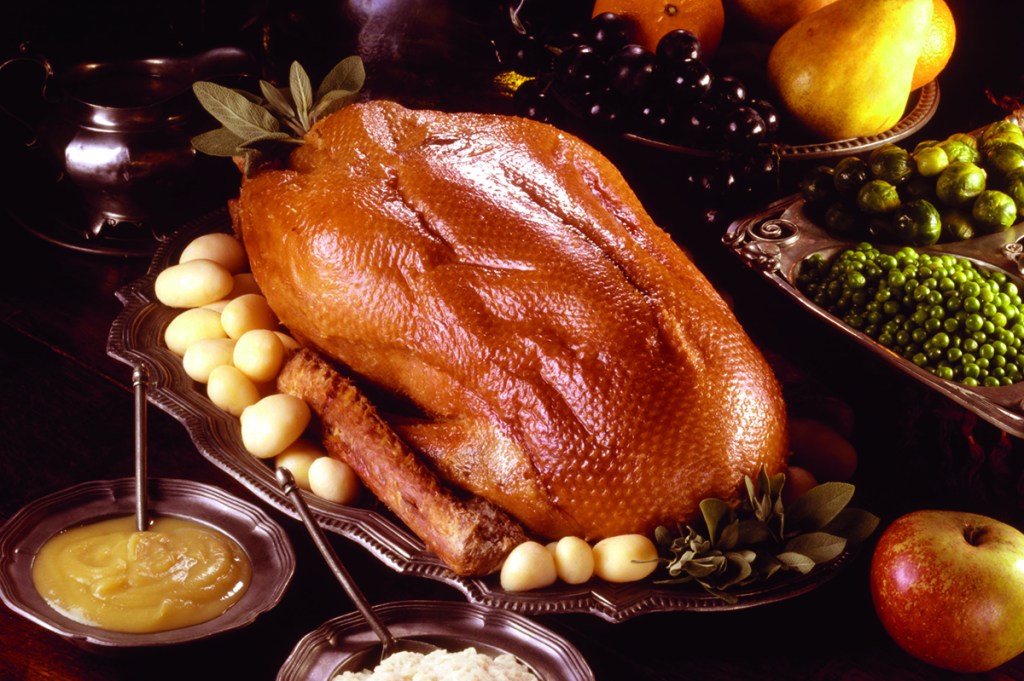Christmas is a truly season of birds. Ornamental peacocks and gilded wrens perch upon the Christmas tree, cardinals and chickadees make themselves at home at feeders and on wrapping paper, and irrepressible robins are ubiquitous. According to a medieval legend recounted in Hamlet, during the season ‘wherein our Savior’s birth is celebrated’, the ‘bird of dawning’ (the rooster) ‘singeth all night long…so hallowed and so gracious is the time’. One presumes the medievals had acquired the skill of sleeping through crowing roosters, or perhaps hallowed and gracious would not have been the chosen terms.
Most non-vegetarians would agree that without the physical presence of Nowell fowls, no hall can consider itself adequately decked, whether boughs of holly are present or not. Duck confit, foie gras, stuffed Cornish hen, chicken liver pâté — what would Christmas feasting be without defeathered friends in one form or another to grace the yuletide board? In earlier centuries, swans and peacocks might have featured on European menus, at least in the homes of the rich and fowl-favoring. Roast peacocks were served in their plumage for additional pizzazz. So were swans, and it was reportedly fashionable to place a burning chunk of incense in their beaks for dramatic effect.
Imported North American turkey began to edge peacock off the table after the 1520s, when William Strickland, the navigator who sailed with Sebastian Cabot, brought some back from the New World; in 1550, Strickland emblazoned an American turkey on his coat of arms. Swans hung on for a while longer, and were still being eaten until well into the 18th century, but eventually they too got floored by the tough-talking gobblers and concluded that sticking to ornamental ponds was better for the health.
The goose, though, was made of sterner stuff. A territorial creature with patrician blood flowing in its veins (papa geese tell stories of a winter’s evening to their little goslings tucked up in the straw about how their ancestors saved the Roman Republic by judiciously timed honking), the goose stared the turkey confidently in the eye, hissing a soft aside about the time it put a phone line repairman and two ASPCA employees in the intensive care unit. The turkey, after strutting back three paces, fanning out its tail and swelling up its chest feathers, decided discretion was
the better part of valor.
Good press helped, too. For a couple of centuries, children spent their formative years having Mother Goose’s nursery rhymes read aloud to them, and the rhyme ‘Christmas time is coming, the geese are getting fat/ Please to put a penny in the old man’s hat’ gradually imprinted itself upon their minds, priming them to seek out goose at Christmas time later in life. Charles Dickens unfortunately reinforced anti-goose stereotypes when he portrayed the Cratchit family bravely struggling in poverty with a small goose, while a converted Scrooge comes to the rescue with the largest turkey available, but in these modern, more enlightened times we know better than to fall for Dickensian cliché. Goose beats turkey any day, and especially on Christmas Day.
What’s more, while goose is a smaller bird, you don’t need as much goose as you do turkey to feel satisfied. Goose is all lean, dark meat, very rich and flavorful, and a little bit goes a long way. Like duck, goose has a thick layer of fat under its skin that melts away while roasting, keeping the bird deliciously moist. The rendered fat is the sort of thing chefs duel over in the back parking lot, hitting each other on the knuckles with meat mallets. It’s runny gold, good for everything from browning potatoes to making oatmeal cookies.
My favorite recipe for goose involves encrusting the skin with sea salt and serving it with sour cherries and porcini sauce. Fruit like sour cherries, pear, fig and prunes (yes, actually, prunes, with a little Armagnac to help them remember their best selves) are a popular accompaniment. Recipes frequently call for red wine, port or Calvados too, especially when apples are involved in the stuffing. Chestnuts are also happily paired with roast goose, in a touch I find very French. I never eat chestnuts without remembering distant days of chestnut gathering in the Alps of southern France, driving for what felt like hours through rolling hills of dark-foliaged cork oaks to get there, and finding the spiny husks split open all over the slope, with three or four glossy brown chestnuts packed perfectly in each like tiny animals in a nest.
It’s as well to be warned before you stand at the dinner table, armed with apron and freshly sharpened carving knife: the anatomy of a goose is a little different from that of a turkey or chicken: blue blood, you know. Royalty is not made like the rest of us. The pros say it is easiest to start by removing the legs, then slicing the breast. Goose has a large cavity-to-meat ratio, and the legs take the longest to cook, but — again like duck — it can be served while still a bit rare, unlike turkey or chicken, which should be opaque and white.
The carcass of the goose can be used as a base for the world’s best onion soup on Boxing Day. Seriously, I have never tasted any onion soup to compare with that made from goose broth. It’s so delicious, rich and nourishing, I think doctors ought to prescribe it in cold season. I defy any germ to attack with such a kingly potion sloshing about one’s insides. You can practically feel the white blood corpuscles racing around inside you muscling up to knock out the invaders.
Robert Southey’s ode ‘To a Goose’ speculates on the bird’s past and on the fate of its plumage — did its quills fall into lawyers’ hands as pens and alter fates and fortunes? Or did they perhaps wind up attached to a household duster? ‘Departed Goose!’ he concludes, ‘I neither know nor care.’
But this I know, that we
pronounced thee fine,
Seasoned with sage and onions,
and port wine.
This article was originally published in The Spectator’s December 2020 US edition.

























